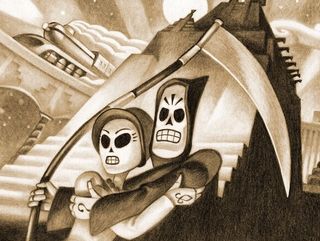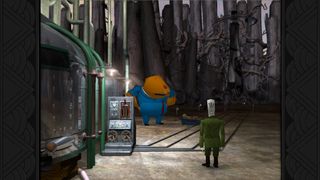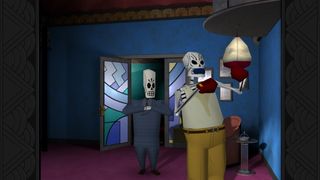Grim Fandango Remastered Review — Almost a Classic
Grim Fandango Remastered is hilarious, gorgeous and sure to delight adventure fans, but it can also feel dated and frustrating.
Why you can trust Tom's Guide

Grim Fandango is a classic, and after playing the remastered version, I can almost understand why.
Don't get me wrong: Grim Fandango Remastered ($15; PC, PS4, PS Vita; PC reviewed) has clever puzzles, hilarious dialogue, gorgeous graphics, memorable music and a perfect atmosphere. But it also has dated gameplay, frustrating roadblocks and a slew of unpredictable technical issues. I wanted to love Grim Fandango. I really did. Instead, I just kind of like it... as a friend.

Dying to Play
When gamers found out that Grim Fandango, a beloved point-and-click LucasArts adventure game from 1998, was getting the HD treatment, the Internet rejoiced. Grim Fandango has been part of pop culture's collective consciousness for almost 20 years, and it's easy to see why.
MORE: Best Games of the Year
The game tells the story of one Manny Calavera, a working stiff with an ax — or, more accurately, a scythe — to grind. Manny works as a Grim Reaper, but it's not all it's cracked up to be. He's just a corporate suit with an unsatisfying job, a smug rival, a loudmouthed boss and no clue what he did in life to deserve this kind of shabby eternity. The best souls get first-class train tickets to the Edenic Ninth Underworld, but all of Manny's clients seem to get shipped in flimsy coffins, or worse.

Everything changes when he reaps the soul of the beautiful, mysterious Mercedes Colomar. Mercedes was an absolute saint in life but gets nothing in death save for a long, dangerous walk toward paradise. Manny suspects that the system is rigged, and from there, he's in for the adventure of an (after)lifetime, complete with intrigue, conspiracy, romance, action and enough laugh-out-loud jokes to fill a moderately sized funerary urn.
Aside from its excellent story, the game absolutely gushes style. With an appealing hybrid of a 1940s detective movie and a Mexican Día de los Muertos aesthetic, the Eighth Underworld is a perfect place to lose yourself for a while. The sly combination of Latin and jazz tunes that populate the soundtrack doesn't hurt, either.
In 1998, incorporating Mexican art styles into video games was uncharted territory, which makes it all the more impressive that the game succeeded with such flying colors. This was a world before Psychonauts and Guacamelee, and those two games owe a lot to Grim Fandango (especially because Tim Schafer, the mastermind behind Grim Fandango, also created Psychonauts).

Feels Like the First Time
I missed out on playing the original game in 1998 because I was too young, and not sophisticated enough to grok the salty humor and mind-bending puzzles. However, I booted up the remastered edition, ready to embrace it, just as I embraced the Monkey Island and Maniac Mansion series of LucasArts games when I finally got around to playing those in high school.

But by the end of the first cutscene, Grim Fandango had frozen. It would not be the last time. The game locked up on me during cutscenes on a regular basis, a problem made worse because Grim Fandango does not offer autosaves. Of all the retro features of the game to recreate, "save early and save often" was probably one modern gamers could have done without.
Grim Fandango is a very traditional (some might even say "old-school") point-and-click adventure game. You'll converse with people, collect items for your inventory, solve puzzles and explore the office buildings, haunted forests, seedy nightclubs and vast oceans of the Eighth Underworld.
There's not much to say about these aspects of the game that hasn't already been said ad nauseam since 1998. The conversations are incredibly well-written, and I guffawed more than once during each exchange. The pre-rendered backgrounds and updated HD character models look great together, and help create a cohesive, visually distinctive world. The puzzles are ingenious, but ingenious does not always mean enjoyable.

A Puzzling Conundrum
Here's the big problem with Grim Fandango, and the one most likely to split new and returning players right down the middle: It's an incredibly frustrating game. Unless you are fantastically in tune with the game's designers, or you consult a walkthrough, you will spend most of your time aimlessly wandering from one place to another, desperately wondering how to advance.
You will figure it out — all of the puzzles have a logical solution — but not before you revisit every screen a few times, try using every item in your inventory and turn off the game to let your ideas stew for a while.
I probably made more progress toward solving Grim Fandango's puzzles while I was away from the keyboard than I ever did in-game. I spent a lot of the game feeling stymied and bored, eagerly awaiting the next story advancement, rather than enjoying the moment-to-moment interactions.

At the risk of some spoilers, consider one puzzle from the game's first act. Manny needs to spy on a rival's business documents in order to score a better contract for himself. The contracts come via a series of tubes, controlled by a central server in the basement.
To solve this puzzle, Manny must get two empty balloons from a clown, fill them both with different kinds of packing material, send them down his own tube, infiltrate the server room, prop the door open, acquire a playing card, punch holes in it and use the card to block an incoming canister.
MORE: 15 Best Mobile Adventure Games
It's a great puzzle. It makes you think long and hard about slight contextual, environmental, and dialogue clues. It's also so incredibly obtuse and roundabout that if you don't solve it the first time (you won't), having to do it again and again is a real pain. If you miss even one part of the complex chain of logic underlying the enigma, there's nothing you can do but aimlessly wander from screen to screen, wondering if you missed something, until you figure it out.
On the other hand, there's no denying that said story is well worth the price. Manny and his eclectic cast of friends and enemies are not to be missed. The enormous, orange Glottis is a speed demon — literally — with a penchant for both car modifications and jazz piano. Domino Hurley, Manny's business rival, could have stepped out of a production of Glengarry Glen Ross. Even Lupe, the bubbly nightclub coat check girl, defines new boundaries in loquaciousness.

Modern Sensibilities
Consider Grim Fandango in relation to The Wolf Among Us, Telltale's recent hit adaptation of the Fables comic series. In The Wolf Among Us, the puzzles are quite simple and straightforward, and couldn't possibly trouble an average player for more than a few minutes. There's a timer on your dialogue options, and you can only choose one response from a possible four. Characters remember and respond to your decisions. The focus is on developing a character and interacting with a world, rather than trying to wrap your head around inscrutable puzzle design.
This isn't to say that modern adventure games are in some way superior to their forerunners; indeed, Telltale owes a lot to games like Grim Fandango, and there's something to be said for giving players a tangible challenge. But if you don't feel nostalgic about Grim Fandango, there's a good chance that you'll feel irritated by it instead. The fact that you’ll spend the other half of your time delighted and impressed only softens the blow so much.
Grim Fandango fans will want to pick up the game and replay it, but newcomers may want to think twice about doing so. It's a unique and inexpensive chance to experience an influential moment in gaming history, but it's also a salient reminder of how much adventure games have changed, mostly for the better, in the intervening 17 years.
Marshall Honorof is a staff writer for Tom's Guide. Contact him at mhonorof@tomsguide.com. Follow him @marshallhonorof. Follow us @tomsguide, on Facebook and on Google+.
Sign up to get the BEST of Tom’s Guide direct to your inbox.
Upgrade your life with a daily dose of the biggest tech news, lifestyle hacks and our curated analysis. Be the first to know about cutting-edge gadgets and the hottest deals.
Marshall Honorof is a senior editor for Tom's Guide, overseeing the site's coverage of gaming hardware and software. He comes from a science writing background, having studied paleomammalogy, biological anthropology, and the history of science and technology. After hours, you can find him practicing taekwondo or doing deep dives on classic sci-fi.

